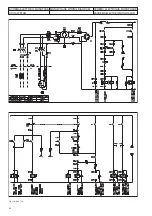
Fig.20 - Abb.20
I
ATTENZIONE
I
WARNING
I
ATTENTION
I
AC H T U N G
I
ATENCION
·
IL CARICO NOMINALE NON PUO’ ESSERE PRESO DA “ZERO”
·
IT IS NOT POSSIBLE TO LIFT THE NOMINAL LOAD FROM" ZERO"
POSITION
·
LA CHARGE NOMINALE NE PEUT PAS ETRE PRISE DE “ZERO”
·
DIE NENNLAST KANN NICHT AB DER NULLSTELLUNG GEHOBEN
WERDEN
·
LA CARGA NOMINAL NO PUEDE SER TOMADA DE “ZERO”
Fig.21 - Abb.21
CAP. 5
FUNZIONAMENTO
I comandi del sollevatore sono situati sulla centralina di comando, dove
trovano alloggiamento: il gruppo motore-pompa idraulica, i gruppi elet-
trovalvole e gli attacchi per l’ allacciamento alla rete elettrica.
I comandi sulla consolle sono indicati in fig.20:
1- PULSANTE DI SALITA:
Tipo “ uomo presente presente “ funziona sotto tensione a 24V, e se premu-
to, aziona il motore e i meccanismi che attuano la salita del sollevatore.
2- INTERRUTTORE GENERALE:
POSIZIONE “ 0 “: Il sollevatore non è in tensione, ed è possibile lucchettare l’
interruttore per impedire l’ uso del sollevatore in caso di guasto.
POSIZIONE “ 1 “: Il sollevatore è in tensione.
3- SPIA ALIMENTAZIONE:
Segnala che il quadro di comando è sotto tensione.
4- PULSANTE ESCLUSIONE FINECORSA ALTO:
POSIZIONATO ALL'INTERNO DELLA CONSOLLE DI COMANDO
Tipo “ uomo presente “ funziona sotto tensione a 24V, ed esclude il mi-
cro di fine corsa salita.
5- PULSANTE DI DISCESA:
Tipo “ uomo presente “ funziona sotto tensione a 24V, e se premuto,
aziona il motore e i meccanismi che attuano la discesa del sollevatore.
A 45cm dal suolo il sollevatore si arresta, per compiere la discesa com-
pleta rilasciare e ripremere il pulsante "discesa".
SEQUENZA DI FUNZIONAMENTO
Prima di salire/scendere dal sollevatore, assicurarsi che le pedane siano alla
minima altezza.
Salire con l’ autovettura sul sollevatore a “ passo d’ uomo “, posizionando la
stessa come indicato in fig. 21.
Posizionare gli appositi tamponi in gomma sulla pedana del sollevatore in
corrispondenza dei punti di presa consigliati dal costruttore dell’ autovettura.
Le rampe di salita possono avere la funzione di prolunga purchè si abbia la
certezza di averle agganciate correttamente prima di sollevare il carico.
Spegnere il motore e innestare il freno di stazionamento dopo aver posizio-
nato l’ auotovettura sul ponte sollevatore e ricordarsi di disinserire la leva del
cambio posizionandola sul “ folle “.
In fase di salita/discesa, il sollevatore deve essere costantemente osservato
insieme al suo carico.
Premere il pulsante ‘SALITA’ no. 1 in fig. 20 e tenerlo premuto finche il ponte
raggiunge l’altezza desiderata.
Per abbassare Il carico, premere il pulsante ‘DISCESA’ no. 5 (fig.20).
A 45cm dal suolo il sollevatore si arresta, per com-
piere la discesa completa rilasciare e ripremere il pul-
sante "discesa" "5".
CHAPTER 5
OPERATION
Car lift controls are located in the control box, where the motor-hydrau-
lic pump unit, the solenoidvalves and the connections to the elec-
tric-pneumatic and hydraulic system are also located.
Controls on the board are the following in fig.20:
1 - LIFTING PUSH BUTTON:
“Dead man control”, 24V operated, when pressed, the motor and the
lifting mechanism are operated.
2 - MAIN SWITCH:
“O” POSITION: lift is not powered. The switch can be padlocked to pre-
vent the use of the lift in case of failure.
“1" POSITION: lift is powered.
3 - FEEDING PILOT LIGHT:
it indicates that the control board is powered.
4- UPPER LIMIT SWITCH BY-PASS-BUTTON
POSITIONED INSIDE THE CONTROL UNIT
“Dead-man-type” switch, operates under 24 V and cuts off the upper li-
mit microswitch.
5 - LOWERING PUSH BUTTON:
“dead man control”, 24V operated, when pressed, the motor and the lowe-
ring mechanism are operated.
At a height of 45 cm from ground the lift will automatically stop. In order
to carry out the remaining descent stroke, release the descent button
and press it again until the lift has reached its ‘zero’ position.
OPERATION SEQUENCE
Make sure the platforms are at the minimum height before lifting/lowering the
car lift.
Get on the vehicle and crawl on the car lift; be sure the vehicle is properly
positionated (see fig.21).
Place the proper rubber pads on the platform so that they are in line with the
lifting points specified by the manufacturer.
The on-ramps can be used as extensions if these are properly hooked befo-
re lifting the vehicle.
Switch off the motor and engage the parking brake after placing the vehicle
on the car lift; furthermore disengage the shift lever and move it to the “neu-
tral” position.
Carefully check the car lift and its load during lifting/lowering operations.
Press the ‘UP’-button Nr. 1 (fig.20) until the lift has reached the required he-
ight.
In order to bring the lift down to the floor, press the ‘DOWN’-button nr. 5 (fig.
20).
At a height of 45 cm from ground the lift will automa-
tically stop. In order to carry out the remaining de-
scent stroke, release the descent button and press it
again until the lift has reached its ‘zero’ position.
35
Summary of Contents for STRATOS SRM
Page 2: ......
Page 49: ......
Page 51: ...QUADRO DI COMANDO CONTROL BOX STEUERTAFEL TABLEAU DE COMMANDE PANEL DE MANDO...
Page 57: ......
















































